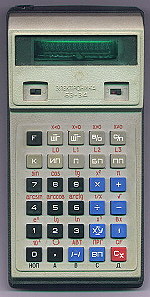...... |
|
How to calculate on theElektronika B3-34 |
|||||||
|
By Sergei Frolov. Please, send your comments, additions and corrections to my grammar. Here is, in brief, told how to work with the calculator B3-34, its analogues B3-54, MK-54, MK-56, and also the MK-61 and MK-52. Information here has been gathered from articles in the magazine "Science and Life". B3-34, MK-54, MK-56, MK-52 and MK-61 have different keyboard symbols. In the table below you can see differences.
The keyboard of the calculator has thirty keys. Each key can perform two
or three actions. On pressing just a key, the action designated on the face of the key
will be carried out. On pressing the For example, we shall calculate a sine from a corner of 37 degrees 30 minutes. First we transform minutes into decimal fraction: 37.5. By setting the switch to G, we enter this number by consecutive pressing of keys. Let's take from it a sine, by pressing keys:
On the display is readable result of a sine: 0.60876144. The display shows:
Numbers of absolute size smaller than 1, and larger than 99999999, are represented in a normalized format - as a floating point number. At the left - mantissa, on the right - exponent. Precisely To enter such a number, at first enter a mantissa, then the sign The calculator, as with any computer, operates with numbers. The numbers are remembered
by machine in special cells of memory - registers. Each register of memory in the
calculator is designated by a figure or letter. Ten registers are designated by numbers
from 0 up to 9, four - initial letters of the latin alphabet (A, B, C, D) or Cyrillics ( When numbers are entered, they are stored in register X, the contents of which is always visible in the display. Each operation is carried out upon one number in the register X (for single number operations) or upon two numbers, where one is in X register and the other in the Y register. A distinctive feature of this calculator is that the operation, which should be made with two numbers, is carried out after input of the two numbers (ie: Reverse-Polish Notation). The numbers, upon which it is necessary to make this or that arithmetic operation,
should be in two registers - X and Y. Numbers may be entered into the Y register only from
the X register. This is done by pressing the key After input of number in both of the registers, it is possible to press a key of the chosen operation. The result will be placed in register X and the contents of register Y are lost. Example: to calculate 3.5 * 2.5 - 1. The keys to press:
Input of any new number into the X register automatically moves the old contents of the X register into register Y. Let's try now to program. Complex algorithms, such as calculation of a ballistic trajectory of an intercontinental ballistic rocket, we shall not consider! Let's try a simple program to calculate the area of a circle. The formula for calculation of the area of a circle is: S = Pi * D * D / 4, where D - diameter of a circle. The constant Pi already is in the
calculator. The size D must be entered from the keyboard (it will be placed in the
register X). Let D = 3. For hand-operated calculating it is necessary to press keys: The same keys and in the same sequence are pressed, when we enter into the calculator the program for calculation of the area of a circle. The program is stored in the calculator as separate commands, each of which is stored in a cell of program memory (some - two cells). There are 98 such cells (memory locations) available in the b3-34 (the MK-61 and MK-52 have 105 cells). It is appropriate that these cells are as addresses - from 00 up to 97. To enter the program into the calculator, it is necessary to enter the keypresses in a
special mode, called programming mode. This is done by pressing two keys The input of each command increases, by one, the contents of the counter of addresses displayed in the right corner of the display. We press
We press
The code 22 has moved to the right, and in its place there is the number 20 - (the code for the function to store Pi in to the X register). In the right corner - 02. To this address the following command "multiply" will be placed. By pressing the appropriate key, we notice that the existing numbers have been displaced to the right, and the code of operation of multiplication has lit up: 12.
The input of each new command now will cause the function codes on the left to be displaced to the right, erasing the rightmost, and the new (just entered) code will be displayed at the left. At the far right is the address of the next available memory cell. All commands are entered this way. To end a program, it is necessary to enter a special
command In normal mode, calculator carries out individual commmands, entered by keystrokes, or
automatically calculates by running the program available in its memory. To start a
program running, press the key To return the calculator in to normal mode from program mode, it is necessary to press
keys: The initial command of the program, entered by us, settles down to the address 00. The
calculator is supplied with a key Thus, to use our program which calculates the diameter of a circle, we enter the
diameter (3) and press Continued on the next page...
|
|||||||||
